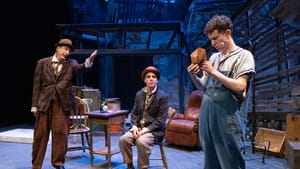Stay in the Loop
BSR publishes on a weekly schedule, with an email newsletter every Wednesday and Thursday morning. There’s no paywall, and subscribing is always free.
Portraying the lives of non-speaking people
Hedgerow Theatre presents Juliette Dunn’s The Puzzle

When I first learned that Hedgerow Theatre was staging an original play focused on the inner world of a non-speaking autistic person, I was surprised that it was called The Puzzle. In recent years, the popular symbol of the puzzle piece has been largely rejected by the autism community. Check out this recent BSR essay by Bridget Scanlan to learn more about the nuances of this issue.
In an introductory panel about the play displayed outside of the theater, the artistic team members explain that they discussed the play’s title at great length with Dunn, “weighing the harmful symbolism against the broader meaning of the puzzle the characters Quinton and Finneas are trying to complete. In this story, the puzzle doesn’t represent the autistic person as a problem to be solved.”
I wondered how the artistic team would portray the inner life of a non-speaking person with autism with complexity and nuance, honoring their humanity and not making their existence a problem to be solved. And how would they do so through the use of clowning? Because I value Hedgerow’s deep and ongoing commitment to disability justice and accessibility, and because I love seeing original plays, I took my seat with an open mind, full of curiosity.
What I know about non-speaking people
I came to The Puzzle as the mother of a 20-year-old non-speaking person who is autistic, and has an intellectual disability as well as bipolar disorder. My parenting journey has been unexpected and full of joy, insights, and challenges. I brought all of this experience with me to see Dunn’s new play.
As a non-speaking person, my son uses assistive technology through a communication device on his iPad that allows him to request wants and needs. He uses other forms of communication, too—he expresses emotions through facial gaze and also through his behavior. He lets us know easily when he’s content, frustrated, excited, bored, scared, delighted, or overwhelmed.
Often, we spend hours comfortably sitting together with no language between us, him listening to music which he loves and me next to him, joining his world at times and also staying deep in my own inner world as I write or read. We come in and out of each other’s orbits through shared smiles, clapping hands, maybe munching on a bowl of pretzels together.
Portrayals of non-speaking people, like my son or The Puzzle character of the Boy (whom Dunn based on her son), are rare in theater, film, books, or other media. My son's life is a mystery to many people, as is my relationship with him.
In attempting to create a theatrical portrayal of the inner life of a non-speaking person, Dunn embarked on a playwright’s challenge and Hedgerow as a company took a risk.
The language of clowning
Dunn creates a world in which two clowns, the naive and sunny Finneas (Daniel Passer) and the jaded, world-weary Quinton (David Shiner), who live in a surreal kind of scrapyard, are the ones to encounter the Boy (Michael Stahler) and ultimately forge a deep relationship with him.
Quinton and Finneas live in a world of repetition, in a Godot-like relationship. Finneas tells Quinton the same jokes every day, hoping for Quinton to laugh (which he does not). But rather than waiting for a Godot to arrive, it’s the clowns themselves who hesitate to finish their puzzle.
When the Boy arrives, dumped into their world like a literal sack of garbage, games of exploration and attempts at communication ensue. The clowns are confounded by his presence, but Finneas finds ways to enter the Boy’s world, to build trust and a common language. His ability to do so upsets the equilibrium that he’s built with Quinton and ignites their conflict.
Complexity and authenticity
The excellence of all three performers keeps the audience engaged in a play that includes considerable repetition. Shiner (who co-directs with Bill Fennelly) is a legendary clown, having performed in circus and in collaboration with Bill Irwin on Broadway; Passer likewise is a Broadway veteran and has been a comedy conceptor for Cirque du Soleil. They make two hours of almost nonstop physical comedy, dancing, and other shtick—which includes spot-on impersonations from iconic films like Taxi Driver—look easy. What an illusion!
Philadelphia actor Stahler also keeps us riveted to the stage with his deeply moving portrayal of the Boy. In The Puzzle’s program, Stahler writes that as an autistic actor, he is honored to bring a part of himself that he has rarely shown in his professional life to the stage. Whether he is speaking or communicating through movement and behavior, Stahler’s understanding of the Boy shines through.
I do wonder whether The Puzzle could be a successful play without the unique skills of these three exceptional performers. Because so few people know and understand the world of non-speaking people, I fear that these characters could become stereotypes in lesser hands.
But here, the performers meet the complexity of Dunn’s script with authenticity and create an evocative, fun theatrical experience.
Navigating our depths, together
I won’t spoil the ending of the play, but I will share that act two is an emotional rollercoaster through the characters’ challenges, surprises about one another and, ultimately, a deeper understanding among them.
The audience was silent in the play’s final scene, rapt in attention. I could sense the man sitting next to me crying. Tears came to me unexpectedly, too. Those moments of intimacy are one of the many reasons that I love theater and why I think that new plays are needed and why this play is needed and why Hedgerow is courageous to stage it.
Each of us carries vast, complex worlds inside of us, even when we struggle to share them. Theater can be a way that we navigate and experience our depths together.
What, When, Where
The Puzzle. By Juliette Dunn, directed by David Shiner and Bill Fennelly. $20-$35. Through June 4, 2023, at Hedgerow Theatre, 64 Rose Valley Road, Media. (610) 565-4211 or hedgerowtheatre.org.
Accessibility
Hedgerow is a wheelchair-accessible venue. Wheelchair seating is available to purchase online.
There will be open-captioning performances of The Puzzle May 24 through 28, a relaxed performance Saturday, May 27, at 2pm, and an ASL-interpreted performance Sunday, May 28, at 2pm.
Masks are optional.
Sign up for our newsletter
All of the week's new articles, all in one place. Sign up for the free weekly BSR newsletters, and don't miss a conversation.

 Gabrielle Kaplan-Mayer
Gabrielle Kaplan-Mayer